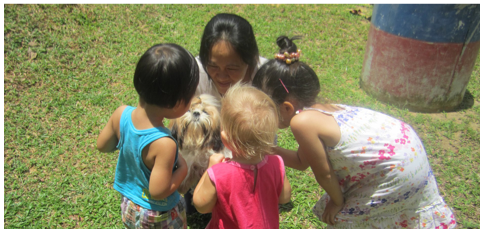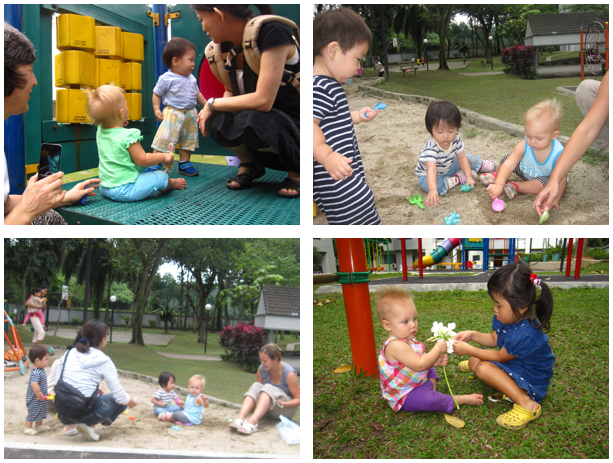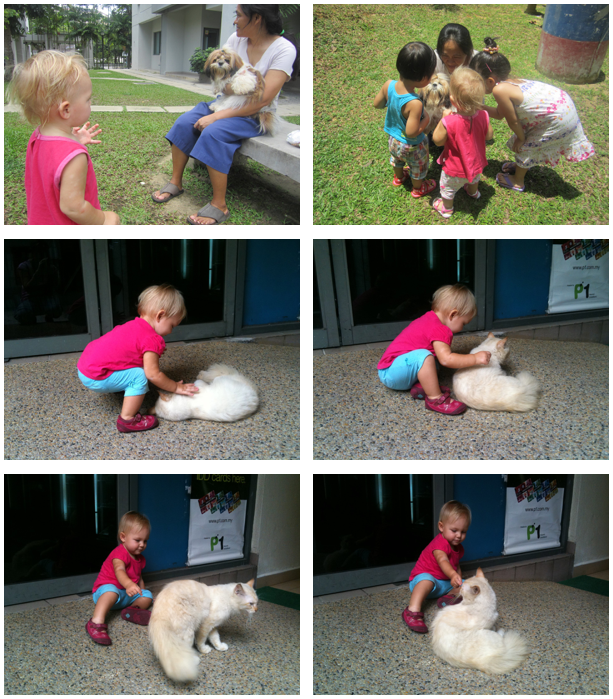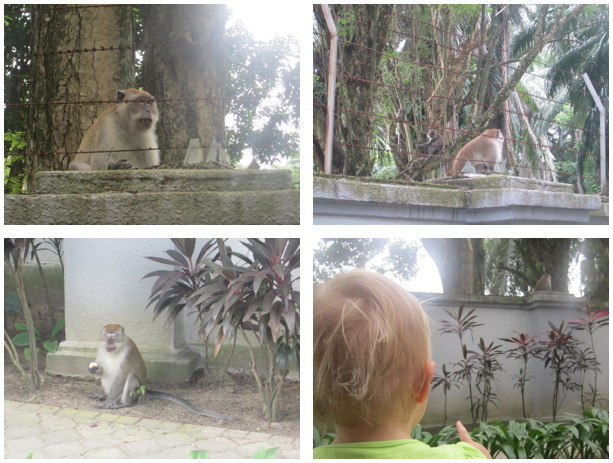
24/04/2011
SĄSIEDZI (OSIEDLOWE PLOTKI) / NEIGHBOURS (CONDO GOSSIPS)
Właścicielem naszego osiedla jest Japończyk, 5 min piechotą od naszego osiedla jest Japońska szkoła (Japanese School of Kuala Lumpur), dookoła jest sporo Japońskich fabryk i firm (między innymi Toyota), tak więc nietrudno się domyślić że 95% naszych sąsiadów to Japończycy.
Na początku wszyscy wyglądali dla mnie tak samo i jak spotykałam mamy z dziećmi na placu zabaw to nie pamiętałam czy spotykam je po raz kolejny czy po raz pierwszy. Nie miałam pojęcia, które dziecko jest której matki, jeśli na placu zabaw było ich więcej niż dwójka. Żadnej z babek nie znam z imienia. Osobiście przedstawiały mi się może nie więcej niż dwie ale dwie minuty później już ich nie pamiętałam.
Na dzień dzisiejszy jestem w stanie rozróżnić prawie wszystkie mamy, chociaż ani jednej nie znam z imienia. Wiem już za to które dziecko należy do której mamy ;)
Imion dzieci znam zaledwie kilka, tych których widujemy często. Naczęściej widujemy Hinako (miesiąc starsza) z mamą i Yumu (dwa miesiące starszy) z mamą. Mama Yumu mówi po angielsku na tyle, że można w miarę prowadzić konwesrajce. Mama Hinako nie mówi za wiele, ale rozumie sporo, ale konwersacji nie da się za bardzo prowadzić. Jest jeszcze jeden kolega (2 miesiące starszy), którego imienia nie pamiętam (a może nawet nigdy nie pytałam) ale widujemy ich często. Z tą trójcą spotykamy się naczęściej na placu zabaw, głównie w piaskownicy, ale i czasami też na basenie.
The owner of our Saujana Villa Condo is a Japanese guy, 5 min walk from here there is a Japanese School of Kuala Lumpur, and there area a lot of Japanese factories and companies around (Toyota for example), so whether we like it or not, about 95% of our neighbours are Japanese.
Shortly after we arrived here, they all looked the same to me and when I met mums with kids in the playground I couldn’t tell whether I met them before or it is the first time. I had no idea which kid belongs to which mother, if there were more than 2 in the playground. I don’t know any of the ladies by their first names. I think there were about one or two that actually introduced themselves but I didn’t make any effort to actually remember the names.
At the moment I am able to differentiate all mums even though I don’t know any names. I can match the kid to the mum, no problems.
As far as the children are concerned, I know few of them by their names, those we meet most often- Hinako (month older than Maya) and Yumu (2 months older). Yumu’s mum speaks English well enough to have some basic conversations. Hinako’s mum knows very little English but she understands a lot, but it is not possible to have a chat with her. There is one more friend of Maya’s (2 months older) but I don’t know his name (and I don’t think I ever asked) but we see him with his mum very often. With those three we meet most often and usually see them in the playground and sometimes in the pool.

W pierwszych dniach zaczęłam widywać też kilka lokalnych twarzy (nie-japonek) - z dziećmi. Szybko zorientowałam się, że to niańki zatrudniane przez Japońskie rodziny. Właściwie to są trzy chyba, że są jescze jakieś o których nie wiem.
Jedna przychodzi na plac zabaw z lekko upośledzonym nastolatkiem, który głownie okupuje huśtawki bądź chodzi bez celu i macha chusteczką.
Inna przychodzi z takim grubaśnym Takahiro (Taka) - właśnie skończył rok i jest bardzo tłusty jak na roczne dziecko, i właśnie uczy się chodzić więc niezłe kilogramy ma do dźwigania. Takahiro ma starszego brata, na którego mama woła Szuta (?) ale nie mam konkretnie pewności jak ma na imię. Dla mnie brzmi to właśnie tak. Mama obu chłopców przychodzi na plac zabaw głównie ze starszym a młodszym prawie zawsze zajmuje się niańka. Nawet jeśli obie są na placu zabaw to mama nie spędza czasu z Taka tylko siedzi i gada z innymi mamami bo starszy syn jest na tyle duży że bawi się sam,
Jeszcze inna nie-japońska twarz to Filipinka, która jest niańką dla dziewczynki o imieniu Rana (2 lata). Rana ma starszeg brata - Ryan i młodszego brata, który urodził się na początku marca (nie znam imienia). Z tą niańką często rozmawiam, bo mówi po angielsku więc jak się spotkamy na placu zabaw to coś tam zawsze pogadamy. Rana w weekendy przychodzi na plac zabaw z tatą, który mówi po angielsku bardzo dobrze więc jak się spotkamy to i z nim trochę pogadam. On sam orygianlnie jest ze Sri Lanki ale nie wiem czy żona też. Przeprowadzili się tu z Japonii i mówią po Japońsku oboje ale imiona ich dzieci nie są Japońskie.
Jest tutaj trochę maluchów w wieku podobnym do Mayki i pojawiają się na placu zabaw w ten czy inny dzień. Fajnie, że Mayka ma się z kim bawić w piaskownicy. Zabierają sobie zabawki, ale też i dzielą się. I wszyscy zgodnie psują babki które my - mamusie - im robimy.
At the beginning of our stay, I noticed a few local (non-Japanese) faces - with kids. I quickly realised these were nannies working for the Japanese families. I actually keep seeing only 3 of them, unless there are more I haven’t met.
One of them looks after a bit disabled teenage boy who mainly occupies the swings or just wanders around without any purpose and keeps waving his handkerchief.
Another one looks after a pretty fat Takahiro (Taka) - he just turned one and is really fat as for a baby of his age. He has just learnt to walk so he has quite a lot of weight to carry around. Takahiro has an older brother whose mum calls him Shuta (?) but I am not entirely sure what is his name. It sounds like that to me. The mum come sto the playground mainly to look after the older kid and the younger one, Taka, is entirely being looked after by the nanny. Even if they are both present in the playground, the mum spends very little time with baby Taka. She mainly sits and chats with other mums as the older sun is old enough to play on his own.
The third non-japanese face is a Philipino nanny, who looks after a 2 year old girl Rana. Rana has an older brother Ryan and a younger baby brother who was born at the beginning of March. With this nanny I speak most often as she speaks English well enough. At the weekends Rana comes to the playground with her dad who speaks English very well so I usually have a chat with him. He is originally from Sri Lanka, not sure about his wife. But they all moved from Japan and both speak Japanese but their kids’ names are not Japanese.
There are a few infants at similar age as Maya and we see them during the week almost every day. It’s good that she has some kids she can play with, or at least play next to, in the playground sandpit. They keep ‘stealing’ one another’s toys but they sometimes share as well. And they all keep wrecking whatever we (mums) build from the sand.

Prawie wszystkie Japońskie mamusie są chude jak patyki. Mają po 1 czy 2 dzieci ale chudziny takie jakby nigdy nie rodziły. Faceci - jak czasem widuje tatusiów z dziećmi to większośc nosi okulary. I chyba to z nimi prędzej bym się dogadała bo podejrzewam że mówią więcej po angielsku niż ich żony.
Mniej więcej co druga babka wychdzi na dwór ubrana w długie spodnie i długie rękawy plus kapelusz czy czapka na głowie. Nakrycie jeszcze zrozumiem ale pocenia się w długich spodniach i długim rękawie nie zrozumiem nigdy. Chyba, że z nimi jest podobnie jak z Koreańczykami - mają wrażliwą skórę i boją się wystawiać na słońce. Albo po prostu nie chcą. Na basenie jak pojawi się jakaś mama z dzieckiem, to przeważnie się nie kąpie (pilnuje dzieciaków z brzegu), albo jak się kąpie to w stroju zakrywającym górną część ciała w całości i w spodenkach. Widziałam może dwie babki, które kąpały się w strojach bikini. Niecodzienny widok. Niektóre dzieci na placu zabaw często są ‘torturowane’ czapką bądź kapeluszem. Pocą się jak cholera bo widze jak im kapie woda spod tej czapki i włosy mokre ale mamy ostro nalegają... Ich włosy są czarne i bardzo gęste więc już to działa jak czapka. A do tego jeszcze dodatkowe nakrycie i mózgi im się gotują... A propo włosów, mówiłam jednej babce że Maya jak się urodziła to miała czarne gęste włosy. babka w szoku, i zapytała czemu zmieniłam jej kolor. Więcj wyjaśniłam, że pierwsze włosy dzieci wypadają i potem rosną nowe. Mayce urosły blond. Ich dzieci rodzą się z czarnymi i często gęstymi i nowe odrastają takie same i pewnie nie zauważają, że to nowe włosy... ;)
Z tego co zaobserwowałam mamuśki bardzo często (do południa i po południu) spotykaja się w osiedlowej kawiarence. Nawet się nie wpraszam ;) Kilka mamusiek starszych dzieci raz w tygodniu urządzają sobie spotkania na kanapach na parterze w hallu naszego bloku. Siedzą i plotkują (chyba) a dzieciaki biegają po placu zabaw.
Większość z nich przyjechała tutaj a właściwie wyemigrowała z Japoni i siedzą tu po kilka lat. Japonia jest drogim krajem więc Malezja jest dla nich tańszą opcją. A mieszkając na takim osiedlu jak nasze praktycznie czują się jak w domu. Czy wracają potem do Japonii - nie mam pojęcia. Jak pytam na ile tutaj są, to mówią 3-4 lata. Możliwe, że i dłużej.
Japońskie imiona przeważnie są długie, 3 sylabowe lub dłuższe. Nie jestem w stanie zapamiętać żadnego jak usłyszę tylko raz. Usłyszę i na drugi dzień nie pamiętam. Zapamiętałam tylko te których widujemy czesto - Hinako, Yumu, Takahiro…
Od początku jak się pojawiłyśmy na placu zabaw z Mayą, niektóre babki zaczęły na nią mówić Maya-chan (czyt. czan). Właściwie to większość z nich stwierdziła od razu, że to Japońskie imię (słyszałam też że Hinduskie). Japońskie imiona mają to do siebie, że dodaje się do nich różne końcówki. Końcówkę -chan stosują do imion małych dzieci, dziewczynek, ukochanych osób i zwierzątek.
Z nie-japońskich sąsiadów czasami widuję nie-azjatycką twarz, przeważnie pojedynczy biznesmeni lub turyści, którzy przyjechali tu na chwilę. Widujemy też nie-japońskie dzieciaki - 3 siostry (zdaje się 4-8 lat), które często się pokazują z babcią i siostrą 21 letnią (chyba, bo możliwe że to ich niańka). Wszystkie są śmieszne i bardzo wygadane, a najmłodsza prawie zawsze przychodzi w jakimś stroju super bohatera - raz superman, raz spiderman, a innym razem batman. Gorąco jak diabli ale ona twardo biega po placu zabaw w długich rękawach i długich spodniach i jeszcze do tego na głowie czapka - część kostiumu.
Mamy też kilka lokalnych psów i kotów (z właścicielami). Jak Maya widzi jakiegoś psa to zawsze musimy się iść przywitać ale nie zawsze ma odwagę głaskać. Kota spotykamy regularnie jednego, który przeważnie wyleguje się pod sklepem. Z nim to już jak z przyjacielem, kot się nas nie boi, jest oswojony i daje się głaskać. Maya dotyka mu oka czy nosa ale ten się nie wkurza wcale. Są jeszcze 3 inne koty ale spotykamy je rzadko. Jeden z nich jak go raz spotkaliśmy i probowaliśmy się zakolegować to trochę na nas syczał i niby dawał się pogłaskać ale za chwilę skakał do nas z pazurami więc postanowiłam, że będziemy go ignorować.
Almost every single mum is very thin. They usually have 1-2 kids but are so thin that you wouldn’t tell they’ve ever been pregnant. Sometimes I see dads with kids and I noticed most of them wear glasses. I think I could have some conversations with them rather than their wives, as they probably speak more English.
Every other mum I see wears long sleeves and long trousers plus a hat or a cap. I can understand the hat but sweating around in long sleeves and long trousers in this weather I don’t understand. I think it might be the same with them as with Koreans - they have sensitive skin and are afraid exposing themselves to the sun. Or they just don’t want to. By the swimming pool, if I ever see any mums with kids, the mums usually don’t swim and stay in the shade watching the kids. If the mum does swim, she usually wears a long sleeve swimming top and shorts. I have seen maybe two mums so far who were wearing bikini. Some of the younger kids in the playground are being ‘tortured’ by wearing a hat or a cap. I can see the sweat dripping from their heads but the mums make sure the hat or cap doesn’t go off... Their hair is black and very thick and this works well as a hat. Anything more on top and their brains are boiling underneath... I once mentioned to one mum that Maya was born with a lot of black hair. She asked me why we had changed her hair colour. I explained to her that babies lose their first hair and then new hair starts to grow and Maya’s second hair is blond. I think their babies are born with black and thick already and they don’t even notice that first hair falls out and new starts to grow ;)
What I also noticed mums meet in the local cafe very often (in the morning and in the afternoon). I don’ even think of joining them ;) Some mums of the older kids meet up in the downstairs hall of our block - they sit and chat (I think) while the kids run around the playground.
Most of them arrived, or rather emigrated, from Japan and they stay here for a few years. Japan is an expensive country so Malaysia is a cheaper option for them. If they happen to live in a condo like ours, they feel like home. I don’t know whether they come back to Japan or not. When I ask how long they would stay here, they usually say 3-4 years, possibly longer.
I noticed that Japanese names are long, usually 3 syllables or longer. I am not able to remember any of the names, if I hear it only once. I hear it once and don’t remember the next day. I only remember the names of kids I see very often - Hinako. Takahiro, Yumu (must be a shortened version of a name).
Since Maya started to play in the playground in November, some mums began to call her Maya-chan. Almost all of them agreed Maya is a Japanese name, (but I also heard it’s Indian). Japanese names’ feature is they add honorifics to the names - different types of endings. So for example the ending -chan is used for babies, young children, teenage girls, but also towards cute animals, lovers, close friends.
I sometimes see non-asian faces, individual guys/businessmen or tourists who come her for shor periods. We also see non-Japanese kids - there are 3 sisters, Malaysians (between 4-8 years old), who go out to the playground with their grandma and a 21 year old sister (or maybe she is their nanny, not sure). They are really funny and very chatty. They youngest always wears soem sort of a superhero costume - spiderman, superman and once even batman. It is freaking hot but she is really determined to wear the long sleeves and long trousers with some sort of a cap on the head as a part of the whole outfit.
There area also a few dogs and cats around (with the owners). When Maya sees a dog, she always wants to come and say hello but she is not always so brave to give it stroke. There is one cat we meet pretty often, usually by the shop. He is like a friend and knows us and we know he doesn’t mind being stroked. Maya sometimes wants to touch its eye or nose but the cat is not afraid. There are 3 more cats but we meet them rarely. There was one we met and we thought it will be friendly but he was sort of hissing when we wanted to stroke it so I decided we will ignore it when we see it.

Od strony południowej za murem naszego osiedla znajduje się pole golfowe. Na palmach przy murze, z obu stron mieszkają małpy. Czasami widać ja przechadzają się po murze, a i raz udało nam się załapać na 'karmienie'. Jacyś faceci z naszego osiedla rzucali im kawałki pieczywa a te chętnie przeskakiwały na naszą stronę i zbierały każdy okruszek. Było ich dosyć sporo, nawet jedna była z młodym. Te nasze małpy generalnie są strachliwe i jak któraś była po naszej stronie a Maya od niej podchodziła to małpa uciekała od razu na mur. Dobre pół godziny tak przychodziły i schodziły i zbierały to jedzenie - miałyśmy fajną rozrywkę. Maya tak zapamiętała te małpy, że teraz jak przechodzimy koło muru to pokazuje palcem i domaga się żeby chociaż jedna się pokazała ;)
From the south side our condo is neighbouring with a golf course. On the palm trees growing by the surrounding wall, on both sides, live monkeys. Sometimes we can see them strolling on the wall and once we were lucky to see them being ‘fed’. Some guys from our condo were throwing pieces of bread on the wall and by the wall and the monkeys were very eager to pick up every single piece of food. There were quite a lot of them and one even was a mother with a baby. They are not very brave as once we come nearer they just run away. It lasted for about half an hour and they kept coming down and up and couldn’t wait to get more. Maya remembered the monkeys and every time we go net to the wall, she keeps pointing and asking them to come out ;)

Przy takim tłumie mieszkańców a głównie dzieci wydawało by się, że na basenie będzie tłoczno. Tak naprawdę z basenu korzysta naprawdę garstka mieszkańców. Jedynie w weekendy najczęściej przychodzą całe rodzinki popluskać się z dziećmi, ale jest ich niewiele. W tygodniu popołudniami najczęściej nikogo nie ma, czasem pluskają się może 2-3 dzieci. Raz jeden jedyny spotkałyśmy w tym samym czasie naszych troje znajomych, więc w czwórke mieli niezłą frajdę.
To trochę tak jakby mieszkać w Japońskim getto. Niewiele z nich mówi po angielsku. W szkole uczą trochę angielskiego i malezyjskiego ale wydaje mi się, że kontakt z ich angielskim poza szkołę nie wychodzi. Trzymają się razem, w sklepach nie potrzebują mówić po angielsku, spotykają się ze swoimi japońskimi znajomymi i na tym się kończy.
Wkręcamy się w japoński klimat jeszcze nawet nie będąc w Japoni. Moja znajomośc języka japońskiego narazie stoi na konichiwa, arigato i sayonara. Może trochę trzeba się poduczyć tym bardziej że a następny projekt zaplanowany jest właśnie w Japoni (jeśli nic się nie zmieni do września).
Dobrze by było mieć jakąś koleżankę z którą można iść na kawę i pogadać na placu zabaw. To byłoby wykonalne jakbyśmy mieszkali w KL (tam jest mnóstwo międzynarodowych mam z dziećmi które spotykam na placu zabaw), ale wtedy Piotrek do pracy miały by dwa razy dalej więc nie warto. Damy rade :)
With such a great number of neighbours, and a lot of kids as well, you would think the pool must be very busy. Well, whenever we go there with Maya, there are barely any people, one or two kids at a time. Usually at the weekends there are whole families spending some quality time. but still, no crowds. Only once we met our three friends from the playground so they had some fun together for about one hour.
It is a bit like a Japanese ghetto. Few of them speak any English. At school they learn English and Malaysian but think their English doesn’t really exist outside school. They stick together, have Japanese friends, and they don’t really need any English in their daily life.
For us it is getting into the Japanese climate, without being in Japan. My knowledge of Japanese language is limited to konichiwa, arigato and sayonara. We could learn it a bit, especially that our next long stay is planned to be in Japan (if no other changes happen till September).
It would be nice to have a friend who I can meet with for a coffee and have a chat in the playground. It would be possible if we lived in KL (there are lots of international mums with kids I meet in the park), but then Piotr would have a double distance to get to work so not worth it. We’ll manage :)
